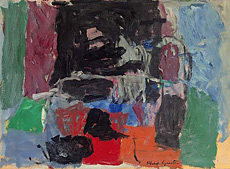

 The light of day Highlights from the Post-War & Contemporary Art morning and afternoon sales The Post-War day sale on 14 November will present a diverse and exciting array of masterworks created in a variety of media. An important selection of paintings will be offered from the Estate of H.H. Arnason, the renowned scholar, critic and avid art collector. He developed a keen eye for quality and many close friendships while visiting artists' studios and writing about their work. On one such visit he selected A Figure 4 on an Elegy from Robert Motherwell's studio after working on the artist's monograph; additionally Philip Guston's Late September was received as a personal gift from the artist. The quality of the works to be offered from this estate are testament to Arnason's profound understanding of the artists he admired. Woman in Landscape from 1964-1965 is a remarkable example of Willem de Kooning's diverse oeuvre. The painting possesses an ambiguity and a sumptuous painterly touch, bordering on vulgarity, which emphasizes de Kooning's interest in uneasy subject-matter. He challenges the perceptions of art-historical tradition by incorporating both abstraction and representation in an aggressive and unflinching manner. His large brushstrokes do not blend but stand side-by-side, allowing the viewer to perceive his technique and, in a way, his artistic temperament. A consummate draughtsman and colourist, he eliminates the traditional barriers between drawing and painting to explore ambiguities between the figure and its background. Warhol's last series of self-portraits is among the most moving and iconic works of his entire career. Depicting the ghost-like apparition of Warhol's gaunt features isolated against a black background and staring wild-eyed directly at the viewer, these self-portraits, more than any of their many predecessors, present a powerful image not of Warhol the man but of Warhol as a phenomenon. Painted only one year before his death, this extraordinary image is stylish in a way that reduces the artist himself to mere decoration. The picture in the sale is one of the rare self-portraits executed in gold, suggesting a religious icon, and thus in a Warholian manner creating an absorbing, thought-provoking pietà for the modern world. This article was provided by the Post-War & Contemporary Art Department, New York |